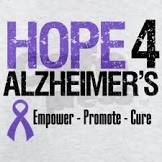 The Alzheimer’s Association estimates that 5.2 million people are living with the disease in this country. Research is continuing to find treatments to slow or stop the progress of the disease. The 5 FDA-approved drugs currently on the market are effective for 50% of those taking them, and none treat the underlying causes. Next generation therapies are concentrating on affecting the various changes to the brains of patients. As with other deadly diseases, it is now assumed that a mix of drugs will be necessary for successful treatment of symptoms, all the while the search for a cure continues. In honor of National Alzheimer’s Awareness Month, we’d take note of some intriguing lines of investigation that focus on amyloid beta peptides.
The Alzheimer’s Association estimates that 5.2 million people are living with the disease in this country. Research is continuing to find treatments to slow or stop the progress of the disease. The 5 FDA-approved drugs currently on the market are effective for 50% of those taking them, and none treat the underlying causes. Next generation therapies are concentrating on affecting the various changes to the brains of patients. As with other deadly diseases, it is now assumed that a mix of drugs will be necessary for successful treatment of symptoms, all the while the search for a cure continues. In honor of National Alzheimer’s Awareness Month, we’d take note of some intriguing lines of investigation that focus on amyloid beta peptides.
A Chinese study appears to prove worsening of cognitive impairment following cerebral ischemia when this peptide is administered. Beta-amyloid is major component of plaques and brain cell death associated with Alzheimer’s. This area holds such promise that scientists are concentrating on therapies that attack stages in the peptide processing, as well as focusing on early detection methods measuring beta-amyloid.
- Leptin Levels: Low levels of the hormone leptin, an appetite regulator, appear to increase the risk of developing AD. Animal studies show that leptin increases cell growth in the brain’s hippocampus, involved in cognitive thinking and memory. Other research concludes that leptin can reduce levels of beta-amyloid, suggesting that decreases in appetite and weight loss could be markers for the disease. Leptin-based interventions are being looked at to slow/stop disease progression.
- Allopregnanolone: A neurosteroid found naturally in the brain and blood, is in clinical testing as a regenerative therapy for AD. Allo, as it is commonly called, was shown to restore memory and learning functions. A controlled treatment and dosing regimen was critical in reducing neuroinflammation and beta-amyloid burden in the brains of mice.
- Alzheimer’s “Eye Test”: A optical imaging test has detected retinal plaques in animals, showing promise as a detection technique for Alzheimer’s in humans. Amyloid plaque buildup in genetically altered mice and human cadavers was found to be similar/equal to the levels of buildup in their brains. Since embryonic retinas derive from the same tissue as embryonic brains this seems logical. Clinical trials are underway on asymptomatic people to determine the potential for early disease detection.
Until there are definitive early detection tests or cures for AD, researchers will continue to pursue avenues for slowing and stopping the progress of the disease in those already afflicted. These include nutritional influences- olive oil and chocolate consumption; lifestyle changes- meditation and yoga; and drug interventions – to reduce inflammation and reduce blood pressure. At the pace and breadth that research is being conducted, can a cure be far behind?
Centra salutes the scientists and caregivers, both professional and non-, who are tending to the millions of AD sufferers and/or seeking to eradicate the disease. If you are an NP, RN, Nurse Manager , PT or OT working with Alzheimer’s patients or looking to enter the field, contact us for employment opportunities at 800 535 0076.